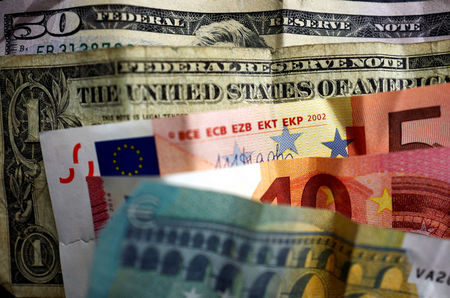
Investing.com – The US greenback slipped decrease Monday, rebounding after latest losses as consideration returned to the potential for commerce tariffs from the Trump administration initially of every week during which the Federal Reserve holds a policy-setting assembly.
At 04:35 ET (09:35 GMT), the Greenback Index, which tracks the buck towards a basket of six different currencies, traded 0.1% greater to 107.310, down greater than 1% this week.
Tariff risk helps greenback
The greenback final week suffered its weakest week since November 2023 as Donald Trump appeared to rein in the specter of commerce tariffs, prompting merchants to cut back the danger premium embedded into the currencies of key buying and selling companions.
Nonetheless, these worries resurfaced because the US efficiently used the specter of import tariffs towards Colombia to safe its coverage intention of returning unlawful immigrants.
“The use of tariffs as a policy lever now looks well understood by the market and perhaps will be worth decreasing marginal volatility,” stated analysts at ING, in a notice. “That said, the FX market is still operating off a potential 1 February deadline for tariffs against Mexico, Canada and China – and that may prevent the dollar from correcting too much further this week.”
The prospect of excessive tariffs on items from nations together with China, Canada, Mexico, and the eurozone, has stoked considerations a few renewed bout of inflation, boosting the US greenback in latest months.
The concludes its newest two-day policy-setting assembly on Wednesday, and is broadly anticipated to maintain rates of interest unchanged.
Euro decrease forward of ECB assembly
In Europe, gained 0.1% to 1.0489 after German enterprise morale unexpectedly improved in January due to a extra constructive evaluation of the present financial scenario, a survey confirmed on Monday.
The Ifo institute stated its elevated to 85.1 in January from 84.7 within the earlier month, whereas the present circumstances index rose to 86.1 in January from 85.1 in December.
This added to final week’s improved eurozone exercise information for January, suggesting that the eurozone financial system is slowly enhancing.
Nonetheless, the remains to be broadly anticipated to chop rates of interest as soon as extra when it subsequent meets.
Merchants are awaiting additional clues from ECB chief that might transfer the needle for the three additional cuts they anticipate this yr after Thursday’s transfer.
“Expect EUR/USD probably to be contained in a 1.0400-1.0500 range for the near term, with the next catalysts for a move being the FOMC and ECB meetings on Wednesday and Thursday respectively,” ING added.
traded 0.1% decrease to 1.2460, with sterling displaying weak spot forward of the subsequent assembly in early February.
“We think there is a good case for GBP/USD to be trading 1.19/20 later this year as the Bank of England picks up the pace of its easing cycle and the chancellor may have to come back to the table with more fiscal tightening later this year,” ING added.
Yuan slips after weak Chinese language PMI information
In Asia, traded 0.6% decrease to 154.76, with the yen benefiting from the Financial institution of Japan growing rates of interest final week.
The central financial institution additionally indicated that it plans further charge hikes if its financial outlook aligns with expectations within the coming months.
traded 0.2% greater to 7.2603, after China’s unexpectedly contracted in January, as latest stimulus measures from Beijing offered solely temporary help to native companies.
In the meantime, development within the additionally slowed considerably throughout the month, with native companies dealing with uncertainty as a result of potential for greater US commerce tariffs.




